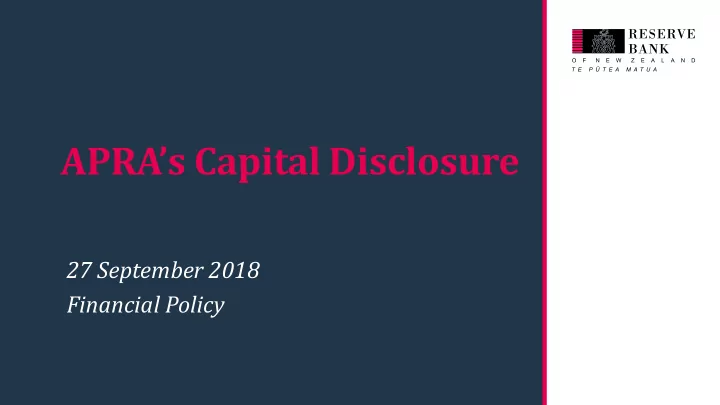

APRA’s Capital Disclosure 27 September 2018 Financial Policy
Background • Aim of Capital Review is to develop most appropriate capital framework for New Zealand • The appropriate capital framework for New Zealand should: 1. Reflect the risks inherent in New Zealand 2. Be practical to administer, and consider relationships with foreign- owned banks’ home country regulators 3. Be transparent to enable effective market discipline • We’ve communicated to banks that we will assess merits of increased alignment with APRA 2
Timeline of the Capital Review Legend for Lead: 2018 2019 2020 Banks RBNZ Aug Sep Oct Nov Dec Jan Feb Mar Q2 Q3 Q4 Q1 - Send final QIS Aug 17 Quantitative Impact Study - Complete QIS Due: End-Sep - Publish consultation End-Nov/ Early paper Dec Ratio Analysis - Consultation period Due: End-Feb 2019 - Publish Regulatory Impact Statement Final End- Decisions March - Confirm final policy decisions - Consult on second- order framework Second-order framework Handbook changes (incl. APRA changes: Q2 to Q4 2019 Restructure & decisions) Framework - Formally consult and changes finalise exposure Exposure draft due: Q4 2019 drafts (BPR / BPG) Transitional - 12 month transition Provisional disclosure under new regime Period period due: Q1 2020 Rural - Discuss individual Early benchmarking results with banks Dec - Send hypothetical Early Oct portfolio to banks - Collect data End Oct Housing benchmarking - Analyse results Due by Early Dec 3 - Discuss individual Feb results with banks
APRA’s current approach Basel • APRA applies conservatism by strengthening APRA CET1 CET1 definition of capital (numerator) and Capital Capital determination of Risk-Weighted Assets < (denominator) Basel • Drawbacks with this approach: RWAs APRA 1. Lower reported capital ratios RWAs 2. Less flexibility in dealing with stress situations • Big 4 Australian banks currently disclose ‘internationally comparable’ ratios, based on Basel CET1 APRA’s 2015 International Comparison Study APRA CET1 < Capital Ratio Capital Ratio 4
APRA’s proposal • Assists measuring achievement of ‘unquestionably strong’ target (top 25% of internationally active banks, in terms of relative capital adequacy) • Focus on capital ratio disclosure; quantum of capital requirements unchanged • Two proposed approaches: 1. Approach 1 – Two ratios: 1 ratio for compliance (APRA ratio), another ratio for disclosure only (internationally comparable) 2. Approach 2 – One internationally comparable ratio, which will be bank- specific and will be adjusted every year by APRA 5
APRA’s proposal Approach 2 Approach 1 11.5% 11.5% 12.0% 12.0% 10.5% 1.0% 10.0% 3.0% 10.0% 2.5% 2.5% 8.0% 8.0% 6.0% 6.0% 8.5% 4.0% 8.0% 8.0% 4.0% 2.0% 2.0% 0.0% 0.0% APRA CET1 ratio Internationally comparable Internationally comparable CET1 ratio CET1 ratio Min CET1 ratio (incl. CCB, APRA Overlay) Excess buffer Min CET1 ratio (incl. CCB) Excess buffer Mortgage RWA adjustment • APRA noted that status quo is an option, although their preferred option is a combination of the two approaches and status quo • APRA to respond to submissions in early 2019 6
Our initial views on APRA’s proposal • Significant challenges with assessing relative capital adequacy: Lack of publicly available data Difficult to determine which jurisdictional differences reflect systemic risk (should not be unwound) and regulatory conservatism (could be unwound) • Other more reliable measures to compare international banks: Dual reporting (standardised approach) Leverage ratio Credit ratings and S&P’s Risk -adjusted Capital Ratio • We will maintain a ‘ watching brief’ on ADI capital framework developments, and provide more thorough assessment in the future 7
Questions 8
Recommend
More recommend